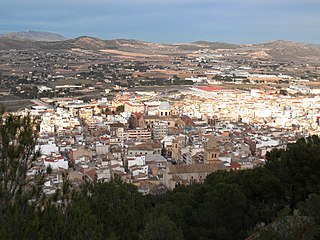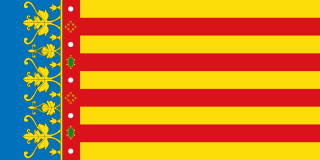
Valencian or Valencian language is the official, historical and traditional name used in the Valencian Community of Spain to refer to the Romance language also known as Catalan, either as a whole or in its Valencia-specific linguistic forms. The Valencian Community's 1982 Statute of Autonomy and the Spanish Constitution officially recognise Valencian as the name of the regional language.

Villena is a city in Spain, in the Valencian Community. It is located at the northwest part of Alicante, and borders to the west with Castilla-La Mancha and Murcia, to the north with the province of Valencia and to the east and south with the province of Alicante. It is the capital of the comarca of the Alto Vinalopó. The municipality has an area of 345.6 km² and a population of 34,928 inhabitants as of INE 2008.

Jumilla is a town and a municipality in southeastern Spain. It is located in the north east of the Region of Murcia, close to the towns of Cieza and Yecla. According to the 2018 census, the town population was 25,547.

Yecla is a town and municipality in eastern Spain with 35243 people registered, in the extreme north of the autonomous community of Murcia, located 96 km from the capital of the region, Murcia.

Pinoso, officially El Pinós/Pinoso is a traditional town which sits located in the mountainous countryside of the Alicante/Murcia border. This traditional town is renowned for the production of fine wines, rock salt and marble. Pinoso has a population of 7,300 and a municipal area of 126 km2. Recently it has experienced a growth in tourism.

Abanilla is a Spanish municipality located in the Comarca Oriental in the Autonomous Community of Murcia. It lies close to the border of the province of Alicante in the Autonomous Community of Valencia.

Tibi is a municipality in the comarca of Alcoià, Alicante, Valencia, Spain. The name of this municipality comes from Latin and it means "for you". This territory was populated with 1,564 people in the year 2018.

The Valencian Community is an autonomous community of Spain. It is the fourth most populous Spanish autonomous community after Andalusia, Catalonia and the Community of Madrid with more than five million inhabitants. Its homonymous capital Valencia is the third largest city and metropolitan area in Spain. It is located along the Mediterranean coast on the east side of the Iberian Peninsula. It borders Catalonia to the north, Aragon and Castilla–La Mancha to the west, and Murcia to the south, and the Balearic Islands are to its east. The Valencian Community is divided into three provinces: Castellón, Valencia and Alicante.

The Region of Murcia is an autonomous community of Spain located in the southeastern part of the Iberian Peninsula, on the Mediterranean coast. The region is 11,313 km2 (4,368 sq mi) in area and had a population of 1,511,251 as at the start of 2020. About a third of its population lives in the capital, Murcia, and a seventh in the second city, Cartagena. At 2,014 m (6,608 ft), the region's highest point is Los Obispos Peak in the Massif of Revolcadores.

Valencians are the native people of the Valencian Community, in eastern Spain. Legally, Valencians are the inhabitants of the community. Since 2006, the Valencian people are officially recognised in the Valencian Statute of Autonomy as a nationality "within the unity of the Spanish nation". The official languages of Valencia are Valencian and Spanish.

The 2011 Murcian regional election was held on Sunday, 22 May 2011, to elect the 8th Regional Assembly of the autonomous community of the Region of Murcia. All 45 seats in the Regional Assembly were up for election. The election was held simultaneously with regional elections in twelve other autonomous communities and local elections all throughout Spain.

The 2015 Murcian regional election was held on Sunday, 24 May 2015, to elect the 9th Regional Assembly of the autonomous community of the Region of Murcia. All 45 seats in the Regional Assembly were up for election. The election was held simultaneously with regional elections in twelve other autonomous communities and local elections all throughout Spain.

The 1987 Murcian regional election was held on Wednesday, 10 June 1987, to elect the 2nd Regional Assembly of the autonomous community of the Region of Murcia. All 45 seats in the Regional Assembly were up for election. The election was held simultaneously with regional elections in twelve other autonomous communities and local elections all throughout Spain, as well as the 1987 European Parliament election.

The 1995 Murcian regional election was held on Sunday, 28 May 1995, to elect the 4th Regional Assembly of the autonomous community of the Region of Murcia. All 45 seats in the Regional Assembly were up for election. The election was held simultaneously with regional elections in twelve other autonomous communities and local elections all throughout Spain.

The 1999 Murcian regional election was held on Sunday, 13 June 1999, to elect the 5th Regional Assembly of the autonomous community of the Region of Murcia. All 45 seats in the Regional Assembly were up for election. The election was held simultaneously with regional elections in twelve other autonomous communities and local elections all throughout Spain, as well as the 1999 European Parliament election.

The 2003 Murcian regional election was held on Sunday, 25 May 2003, to elect the 6th Regional Assembly of the autonomous community of the Region of Murcia. All 45 seats in the Regional Assembly were up for election. The election was held simultaneously with regional elections in twelve other autonomous communities and local elections all throughout Spain.

The 2007 Murcian regional election was held on Sunday, 27 May 2007, to elect the 7th Regional Assembly of the autonomous community of the Region of Murcia. All 45 seats in the Regional Assembly were up for election. The election was held simultaneously with regional elections in twelve other autonomous communities and local elections all throughout Spain.

Raspay is a village in the municipality of Yecla, eastern Spain. Its population consisted of 100 inhabitants in the year 2017.
There is not consensus and agreement in the demarcation of the comarcas of the region and some of them varies largely depending on the comarcas proposal. According to La Verdad newspapers’ Region of Murcia Atlas, there are three main divisions corresponding to three different authors.

The murcian nationalism or murcianism is a nationalist school of thought affirming the Murcian nation, as a people.















